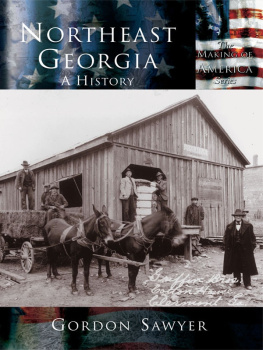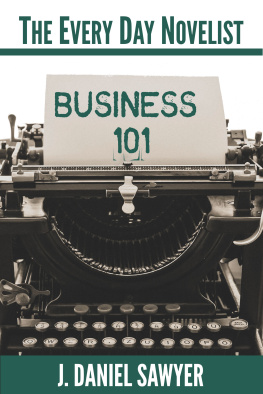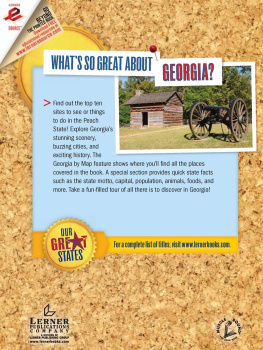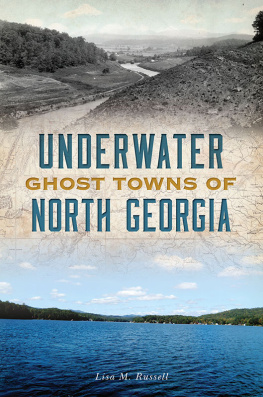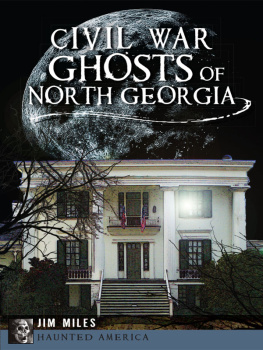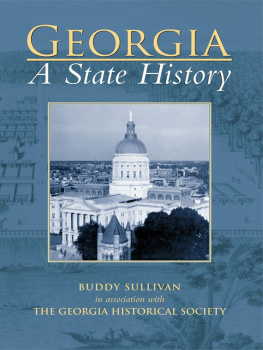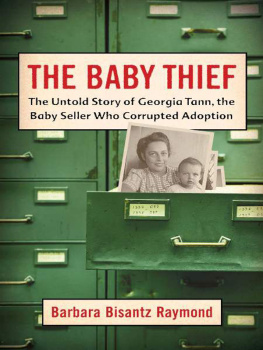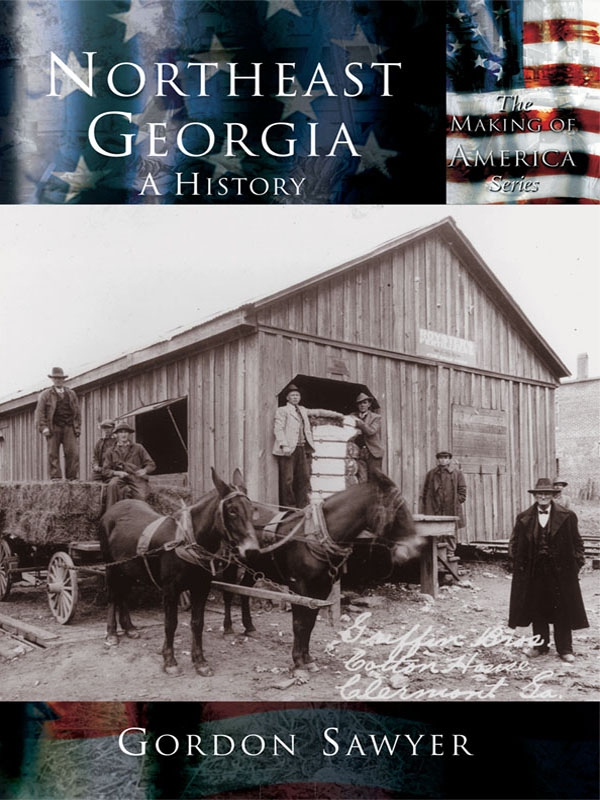ACKNOWLEDGMENTS
The history of Northeast Georgias mountain trade area is different from traditional Georgia history, which usually focuses on a plantation culture, the Civil War, and an agrarian economy. Even so, tucked away in almost every old book about Georgia you will find valuable bits and pieces of history describing life in Northeast Georgia: the Cherokee Indians, traders buying buckskins, the Trail of Tears, the gold rush, summer resorts, waterfalls, and hydro-electric power.
So, first and foremost, I would like to thank the historians, most of them long gone, who recognized that Georgias mountain region was different, but made mention of it anyway. My thanks, also, to the people who saved (and identified) old photos and maps and made them available.
The Georgia Department of Archives and History is an excellent facility, staffed by knowledgeable professionals and willing helpers, and I thank them all. Many people at the archives helped with this volume, but I would especially like to acknowledge Gail Miller DeLoach, who guided me to many seldom-seen old photographs.
The Hall County Library, in Gainesville, holds a treasure of history about the mountain trade area, and I would like to thank Library Director Susan Stewart and Ronda Sanders, for their patience and help. And thanks to Sybil McRay, who, years ago, convinced the library that it should be the repository of original history, documents, and photographs about Gainesville and Northeast Georgia. A number of other organizations have been helpful in this work: the Georgia Mountain History Museum at Brenau University; the Dahlonega Courthouse Gold Museum; the Chestatee Regional Library, in Dahlonega, which houses the Madeline K. Anthony Collection on Georgias gold rush; and the museum at the Sautee-Nacoochee Community Association. I would like to encourage the history societies that have formed, and are forming, in the mountain area. Many have been helpful in this work.
To Olin Jackson, the dedicated and capable editor of the North Georgia Journal , thank you for all your help, and for your guidance and encouragement. To the late Sylvan Meyer, who also worked with us in building the North Georgia Journal , I wish you could be here to participate in the book signings.
Richard Stone, the old-photograph magician from beautiful downtown Talmo, Georgia, deserves credit for many of the pictures in this book. Rick has always been professional in getting the most from faded photos, but his work with the new digital equipment lifts the science of restoring photos to a whole new level.
The illustrations covering the pre-photography history are the work of John Kollock, who not only is the premier artist of Georgias mountains, but also one of the best and most accurate historians of the area. The maps are the work of Jim Chapmanartist, graphic artist, and writer-recorder of the human side of life in Northeast Georgia.
Bob Rogers, the retired but still active photographer who lives in the mountains at Skylake, provided some of the mountain pictures. His personal collection of mountain photographs is spectacular.
A special thanks to my English professor daughter-in-law, Cathryn Sawyer, for all the work and the many hours she spent on this project. And to Cathryn and my wife, Jean Sawyer, for encouraging me to keep going when things bogged down.
And finally, as a point of personal privilege, I would like to thank the late Ralph McGill, editor of the Atlanta Constitution , who first turned me on to the history of Northeast Georgia when I was a young, green cub reporter who drew the assignment every now and then of driving the good editor to an out-of-Atlanta speaking engagement.
One of the pleasant things about doing local history is meeting people, talking with them, and finding them to be willing workers; helping dig out information, old photos, and documents; and helping any way they can. I thank you all.
Because this book is intended as general information for those interested in Northeast Georgia, and not a scholarly document, I have avoided using extensive end notes. However, for those who might want to know where information originated, or who wish to dig deeper into any subject, it seems appropriate to list my major sources, which appear at the end of the work. Even so, it should be accepted that this is my version of the history of Northeast Georgia. If you think I am in error, the buck stops with me, not my sources.
NOTES
CHAPTER ONE
White, Max E. Georgias Indian Heritage . p. 122.
CHAPTER TWO
Robinson, W. Stitt. The Southern Colonial Frontier 16071763 . p. 184.
Rouse, Parke, Jr. The Great Wagon Road . p. VII.
Ibid., p. VII.
CHAPTER THREE
Robinson, W. Stitt. The Southern Colonial Frontier 16071763 . p. 67.
Turner, Frederick J. The Frontier in American History . p. 246.
Garrett, Franklin. Atlanta and Environs: A Chronicle of Its People and Events . Vol. 1. p. 1.
Coleman, Kenneth. A History of Georgia . p. 133.
Ehle, John. Trail of Tears: The Rise and Fall of the Cherokee Nation . p. 390.
CHAPTER FOUR
Dahlonega Courthouse Gold Museum. From papers in the museums collections.
CHAPTER FIVE
Garrett, Franklin. Atlanta and Environs: A Chronicle of Its People and Events . p. 143.
Ibid., p. 145.
Bining, A.C. The Rise of American Economic Life . pp. 322323.
CHAPTER SIX
Housch, Linda Gail. The Daily Times . March 23, 1969. p. 9C.
Coleman, Kenneth. A History of Georgia . p. 151.
Ibid., p. 151.
Piston, William Garrett. Lees Tarnished Lieutenant . p. 68.
Ibid., p. 137.
Ibid., p. 155.
CHAPTER EIGHT
Jackson, Olin. A North Georgia Journal of History . p. 83.
From Georgia Life Magazine as quoted in A North Georgia Journal of History , p. 84.
Noble, Ben, and Olin Jackson. Lakemont, GA: The Early Years . p. 1.
Ritchie, Andrew Jackson. Sketches of Rabun County History . p. 431.
CHAPTER TEN
Dorsey, James. The History of Hall County, Georgia . p. 261.
Ritchie, Andrew Jackson. Sketches of Rabun County History . p. 483.
Roberts, William P. Georgias Best Kept Secret: A History of North Georgia College . p. 7.
Lane, Mary C. History of Piedmont College . p. 23.
Ibid., p. 35.
CHAPTER ELEVEN
Bining, Arthur Cecil. The Rise of American Economic Life . p. 359.
Industrial Georgia . A booklet located in the Textile Room at the Georgia Mountain History Museum at Brenau University.
CHAPTER THIRTEEN
Lumsden, Tom. Nacoochee Valley: Its Times and Its Places . p. 10.
CHAPTER FOURTEEN
Davis, Robert Scott, Jr. An article in A North Georgia Journal of History . Vol. II. p. 214.
Ibid., p. 214.
Ibid., p. 217.
Dabney, Joe. Mountain Spirits . p. XIV.
CHAPTER FIFTEEN
Sawyer, Gordon. The Agribusiness Poultry Industry . p. 92.
Georgia Review . Fall, 1952.
Sawyer, Gordon. The Agribusiness Poultry Industry . p. 155.
Ibid., p. 103.
CHAPTER SIXTEEN
Coughlin, Robert David. Lake Sidney Lanier . Preface.
Cook, Joe, and Monica Cook. River Song . p. 256.

